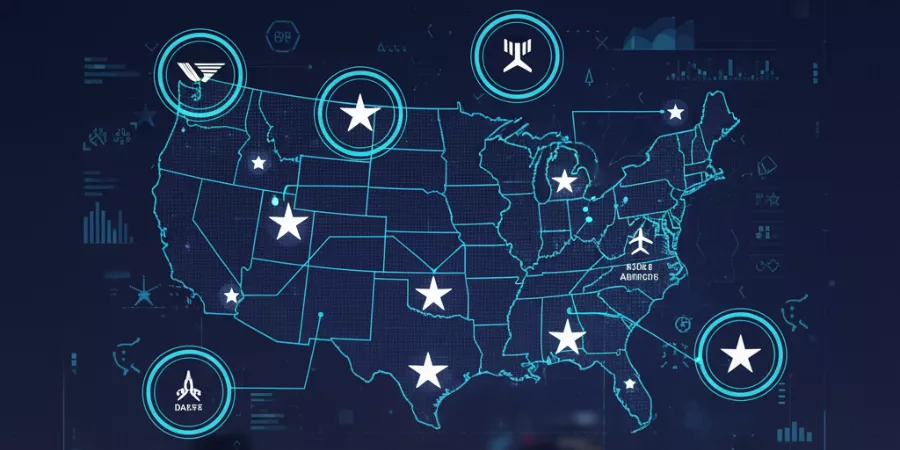The scale of modern aviation in the United States is staggering. For example, one airport alone handled over 108 million passengers in a year. These numbers matter because airports act as gateways not just for travel but for commerce, tourism, and local economies. If you want to understand the biggest airports in the USA, focusing on annual passenger volume gives one of the clearest pictures. What this really means is that the busiest airports in the US carry a huge share of the country’s air traffic load, and their performance influences how we travel, how airlines deploy fleets, and how cities develop airport infrastructure.
In the list below we will walk you through the top 6 biggest airports in the US by recent volume, what makes each one stand out, and what it means for travellers and industry alike.
1. Hartsfield–Jackson Atlanta International Airport (ATL)
Situated in Atlanta, Georgia, this airport continues to be the most significant one in the United States with regard to passengers. This airport welcomed about 108 million passengers in the year 2024. The airport is the main base for several major airlines, including American Airlines, thus connecting more than 150 domestic and 70 international destinations.
ATL airport has always been at the top, and also its ability to handle such a large passenger volume. In case of travel into or out of the USA, this airport is the most likely one to be the central point of the network. All this means for the travelers is that they have a wide range of options, but also might have to deal with more people and the risk of being placed on standby if they are flying to and from regional or less-frequent routes.
2. Dallas/Fort Worth International Airport (DFW)
The airport that is next in line is located in the Dallas-Fort Worth metro area, which is in Texas. DFW airport was able to accommodate about 87.8 million passengers in 2024, which is a staggering number. This also ranked DFW among the world’s busiest airports. Its association with American Airlines and its strategic location enable DFW to cater to a significant part of the US and international markets.
The passenger enplanements and the size of the airport translate into strong airline connectivity and a wide variety of routes at DFW but on the other hand, the high numbers indicate that transfer planning and possible delays are crucial. It is wise to allow for a long layover if you are passing through DFW.
3. Denver International Airport (DEN)
In the mountain region of Colorado, Denver International Airport has grown rapidly and handles tens of millions of passengers each year. According to recent figures it handled around 82 million in 2024. What sets DEN airport apart is its strategic location: it serves as a connecting hub for flights between the US east and west, and even for some international routes. For travellers headed to ski resorts, central United States, or inflight connections near the Rocky Mountains, it offers both convenience and scale. The large size at the same time implies that the walking distances can be long and the daily flights might be separated by a longer time, thus time management becomes essential.
4. Chicago O’Hare International Airport (ORD)
Chicago’s main airport is O’Hare, which is also one of the biggest airports in the USA. In 2024, it was reported that the airport had over 80 million passengers, indicating a strong recovery and a remarkable growth rate. Moreover, it was the second busiest airport in the US globally in terms of aircraft movements. ORD airport is indispensable not only for domestic travel but also for international connections, as it operates with a large variety of airlines and destinations, including United Airlines.
This could result in different routing options for the customer. However, the downside to this is that the heavy passenger volume may lead to gate changes, long distances to walk, and airport congestion besides the numerous flights and connections. If you are transferring at ORD, then giving yourself some additional time and being aware of terminal changes will certainly be a benefit for you.
5. Los Angeles International Airport (LAX)
On the West Coast, LAX airport stands out for heavy international traffic and passenger numbers. In 2024 its passenger count was around 76.6 million. As a gateway for flights to Asia, Australia, Latin America, and domestic west coast routes, LAX combines local and international gateway significance.
For the traveller flying into or out of L.A., this means many long-haul options, but also the reality of heavy traffic and often busy terminals. If you value scenic views, airport lounges, or shopping, LAX has strong offerings, but expect the crowds. Los Angeles World Airports-LAX plays a vital role in maintaining airline connectivity across continents.
6. Miami International and Detroit Metropolitan Airport
Both Miami International and Detroit Metropolitan Airport hold critical positions in the list of busiest airports in the US. These mega airports support extensive airline connectivity and serve as vital international gateways for travellers heading to Latin America and Europe. The daily flights at these airports support tourism and trade, making them essential for the economic impact of major US airports.
What this really tells us about “biggest airports in the USA”
Looking across those five airports you see patterns.
- First, the top 6 biggest airports in the USby passenger volume serve as major hubs, centres where many flights converge, connect, and depart. They offer broad route networks, airline choices, and international links.
- Second, large volume means that every aspect of the airport passenger experience in the USAis amplified: walk times, security lines, the number of shops and eateries, and the impact of delays or cancellations.
- Third, their size matters not just in area but in operational scale: handling tens of millions of passenger enplanementsgets logistics, staffing, and airport infrastructure into complex territory. For airlines and for airports, staying efficient at that scale is a major challenge. From a traveller’s perspective, picking the time of day, knowing your terminal layout, and allowing extra time become important.
Lastly, the presence of these busiest airports shapes regional economies, real-estate zones, and transit systems. A biggest airport in the USA is not just a travel hub, it is an economic engine contributing to the economic impact of major US airports and influencing US airports by passenger traffic across the nation.
Clear takeaway
The largest air travel hubs in America define more than connectivity. They represent progress, technology, and opportunity. For travellers, understanding the travel planning for busiest US airports can make journeys smoother. For policymakers, it highlights how airports in the United States drive national growth.
From United Airlines operations at DenverInternational Airport and ChicagoO’Hare International Airport to Los AngelesInternational Airport, John F Kennedy International Airport, New YorkJFK International Airport, George Bush International Airport, Salt Lake City Airport, Toronto Pearson, and Dubai International Airport, each plays a role in connecting the world. According to the Airports Council International, these mega airports continue to redefine global connectivity through scale and service, keeping US international airports for travellers among the most advanced globally.














